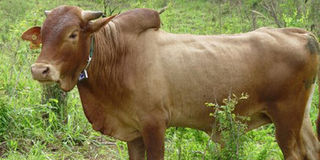Finally I sold the beast, thanks to Christmas

When estimating the weight of a bull, you have to measure its girth and length. PHOTO | STELLAR MURUMBA | COURTESY
What you need to know:
- Most calls came from brokers, who wanted direction to my farm so that they can ‘view’ the animal.
- I put the price of the bull at Sh1 million and the brokers disappeared.
- With more than Sh140,000 in cash, I had already surpassed my target with over Sh40,000.
After losing an opportunity to sell our bull to a governor at the last agricultural show in Nairobi for Sh1 million, I waited anxiously for the next opportunity to offload the animal.
The just-ended festive season offered me an excellent opportunity to sell the bull, christened Kimeni, due to the white marks on its forehead.
I wasn’t going to let Kimeni leave its pen for Sh100,000.
So to up my game, I uploaded its photos online to reach a bigger market.
Most calls came from brokers, who wanted direction to my farm so that they can ‘view’ the animal.
Every potential buyer who came examined the cow and gave it a weight and quoted their price. Nyori, a broker from Ruai was the first.
From his facial expression, I could notice he was amazed by the size of the bull. I even wondered how it would fit in his old rusty Datsun.
“For this one, I would give Sh50,000,” he said in a manner suggesting he had never paid such kind of money for any other animal.
“No thank you, even if you triple the amount, I wouldn’t take it,” I said dismissively.
Even before he left, another buyer came, a tooth pick sticking out of his mouth.
His name was Esau wa Ngombe from Njiru. “Mkulima, you got such as big bull,” he said in astonishment. “Hii ndume mafuta ndio iko mingi, nyama hakuna (this bull only has fat, not meat)” he added with sarcasm as he rounded the bull examining it.
I realised going round an animal was a ritual many brokers do before buying.
“Take Sh75,000. That’s great for your good work,” he pompously said. I dismissed him.
The third buyer sounded more informed about cattle. “The dressing percentage of this bull seems high,” he said with a tweng, which is rare of slaughterhouse guys.
BULL MEASUREMENTS
He added, “The percentage of the live animal weight that will be carcass weight of this bull can be about 62-64 per cent,” he continued to astonish us with terms.
“Get Sh100,000 we close this business,” he said as he started to count some notes.
“Huyu kizungu ndio ako nayo, lakini pesa hana (He only speaks good English but he has no money)” Wakageorge, who was standing by me as an adviser, said in dissatisfaction.
As the crowd was becoming bigger, it attracted even the Nairobians and their friends who were home for December holidays.
It’s common to see Nairobians going to farms and admiring crops and livestock like tourists during the festive season.
One of Thamweli’s city friends, Dr Wameyo, who I later learnt is a renown vet in Nairobi, came to rescue the situation. He called me aside. “Young man, it’s always good to estimate the weight of your bull before selling it,” he said after introducing himself.
“We have already done that by looking at its size,” I interrupted him. “No.”
“To estimate the weight of this bull, we will just measure the girth and length,” he explained.
“Girth measurement is taken by passing the tape behind the forelegs round the animal. The length is found by measuring in inches the distance from the point of shoulder to the point of hipbones,” Dr Wameyo continued.
“Multiply the length of the bull in inches with that of the girth. When the girth is below 65 inches divide by nine, when the girth is between 65 and 80 inches, divide by 8.5. When the girth is above 80 inches, divide by 8. You will get the weight in seers and a seer is = 0.933kg.”
“Also note that if the length is more than 64 inches, divide by 880, if is less than 64, divide by 800,” he concluded his difficult formula.
A PARTNERSHIP
After a few calculations on his palm, he dropped the bombshell. “This bull weighs approximately 500kg,” he said while cleaning his hands.
All the buyers and brokers started murmuring since they had given it at not more than 200kg.
“Mkulima, there is no need of selling this bull to the brokers,” Wakageorge whispered to me. “Why?” I asked.
“With all these Nairobians in Mashambani and no butchery here, this will be a hot business if we slaughter it here,” he explained. “Look, you can deal with the steak meat and I will handle mutura, matumbo and soup,” he convinced me.
“But where shall we do this business?” I asked. “I can convert Check Point Hotel into a butchery,” he added. It was a deal.
I put the price of the bull at Sh1 million and the brokers disappeared.
Mkulima Mixed Farm immediately became a beehive of activity.
I did not bother much about the legal issues associated with running an abattoir but I asked the vet, who had now become a friend, to assist me with the inspection and promised him 3kg of meat.
By 10am, Check Point Hotel was converted into a butchery. By end of the day, we had sold 412kg at Sh350.
With more than Sh140,000 in cash, I had already surpassed my target with over Sh40,000.
This was besides money from soup and matumbo, which Wakageorge is still reconciling two weeks later.
Several villagers still owe me cash for kilos of meat they took, promising that their sons would send them money over Christmas and they will pay.
As I push them to pay, I am still happy I finally sold the beast.





